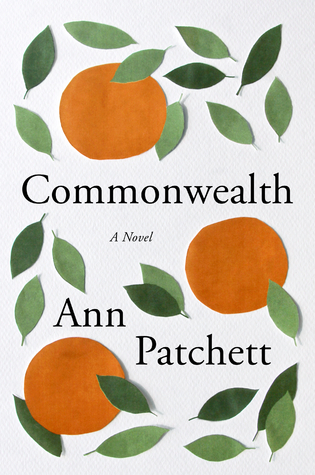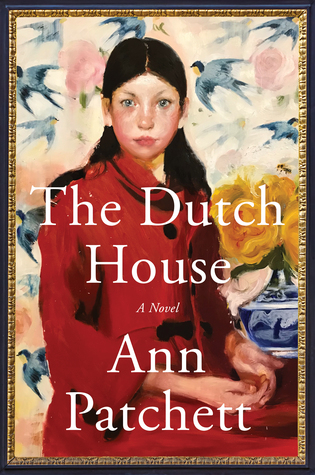“Half the things in this life I wish I could remember and the other half I wish I could forget.”
Ann Patchett’s engaging novel, Commonwealth, begins in the 1960s, in California, at the home of detective Fix Keating. It’s his second daughter, Frances’s christening, and while most of the guests are fellow detectives, there’s a gatecrasher, Albert Cousins, otherwise known as Bert, a lawyer from the district attorney’s office. Bert attends, bringing along a bottle of gin, and it’s on this day that the lives of the Keating and the Cousins families begin to blow apart, but no one knows it yet. Taken that way, in hindsight, the christening party is a moment in time, a moving snapshot of the lives of Patchett’s characters. The novel, rooted in that event, then extends out over the next fifty years with other snapshots, following the lives of its characters as they merge for various events–some happy, some tragic, and some just marking the passage of time.

Bert, who hails from Virginia, is an unhappily married man, but he doesn’t acknowledge it. He dragged his wife, Teresa to California, and now they have three children, Cal, Holly, and Jeannette, with another one on the way (who’ll be a second boy, a “pyromaniac” named Albie). Bert gatecrashes the christening as an excuse to not engage with his overworked wife, demanding children and the chaos called home. As the novel continues, we see that avoidance is a way of life for Bert, and it’s a pattern of behaviour that will have dramatic, tragic consequences for the other characters.
The stunningly beautiful, blonde Beverly Keating, who catches Bert’s eye, has two daughters with Fix: Caroline and Frances (Franny). There’s a sense about her that she’s the kind of perfect woman who will always land on her feet, and that feeling is proved correct as the plot reveals her various incarnations.
Beverly was always in the pictures the children brought back from summer, as if Catherine Deneuve happened to wander by while they were playing in the pool or swinging in the swings and stepped accidentally in the frame as the shutter snapped.
So here we have a cast of four adults: Fix and Beverly Keating, Bert and Teresa Cousins and between them, six children. Over the course of fifty years, we see divorce, families blending, with Bert and Beverly becoming less-than-enthusiastic stepparents, and as the six children merge into one ad-hoc family, they develop relationships among themselves, creating bonds strengthened by being set adrift. Although these 10 characters have a shared history, exactly what that history is is open to interpretation. In adulthood, Franny, a young woman who can’t quite find a path in life, meets a much older, successful author, who takes her childhood story, makes it into a bestselling book, and this causes questions to arise, once again, about the past.
Some reviews state that the novel is plotless. Rather, let’s go back to that snapshot image. Patchett doesn’t give us a linear narrative, and takes us back and forth in time, concentrating on some characters through significant family events, so we see how certain choices develop into major pathways. Teresa is the unsung hero here, struggling to manage a job to support her four children and receiving very little credit for it.
In Commonwealth, and the title is explained as the plot plays out, Patchett has created an engaging, tender look at the lives of her characters. It’s the bite of the narrative, the power of perspective and Patchett’s adept portrayal of messiness of life that elevate this novel.
Here’s Fix talking to his daughter Franny:
“And how about old Bert? How’s he doing?”
“He seems okay.”
“Do you talk to him very often?” Fix asked, the soul of innocence.
“Not nearly as often as I talk to you.”
“It isn’t a contest.”
“No, it’s not.”
“And he’s married now?”
Franny shook her head.
“Single.”
“But there was a third one.”
“Didn’t work out.”
“Wasn’t there a fiancée though? Somebody after the third one?” Fix knew full well that Bert had had a third divorce but he never tired of hearing about it.
“There was for a while.”
“And the fiancée didn’t work out either?”
Franny shook her head.
“Well that’s a shame,” Fix said, sounding as if he meant it
Caroline recently posted about errors and cliches in a short story written by Ann Patchett called Switzerland that is part of the novel Commonwealth. After reading Caroline’s post, I had reservations about reading the book. My concerns turned out to be unfounded–Commonwealth was excellent–I loved it, but if I had to pick fault with the novel, then that complaint would be the section in which Teresa flies to Switzerland to meet her daughter, Holly. We don’t see a lot of either Teresa or Holly in the book, and this section, which stuck out as clunky, did not blend well with the rest of the story. But apart from that, Commonwealth is an entertaining, engaging read.
Review copy



You must be logged in to post a comment.